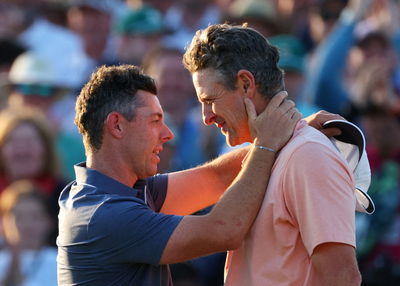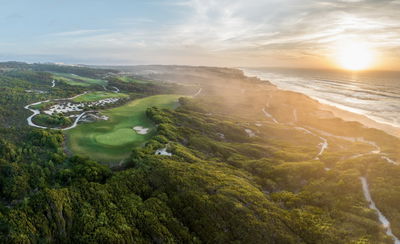The day I played Augusta
...a hacker's guide to the US Masters course

The magic words "y’all both in!" spoken excitedly with a Georgia drawl by the press secretary at Augusta National eleven years ago this week will live long in the memory.
That was the moment the golf correspondent of the Los Angeles Times and I were advised our names had been plucked from a lottery of over 400 journalists to play a round of golf over the hallowed course which hosts the US Masters.
Every year nearly 1,000 of my colleagues turn up in Augusta to pack the hi-tech media centre to report on the world’s most exclusive professional tournament and wallow in the history and immaculate surroundings.
It’s an elite ticket available to only a chosen few lucky enough to work in the golf business, and 1991 was my first year there as Editor of Today’s Golfer magazine.
Not knowing the ropes, it wasn’t until the end of tournament play on the Friday night that I was advised that, subject to my return flight arrangements on the Monday after the Masters had finished, I could put my name forward to play the course at dawn, along with a handful of other hopefuls - journalists, photographers, cameramen, technicians and commentators.
A draw would take place at mid-day during the third round. I was told it was a long shot because some had been coming for many years – and never got a sniff of a place on the first tee at 7am on Monday morning.
What the hell…they say, ‘if you don’t buy a ticket, you can’t win the raffle.’
Sitting next to my colleague from LA in the bustling press centre, the conversation turn to the media draw and we set off to see if either of us had been lucky.
As we approached the reception desk, Martha Grey, recognised us and uttered those immortal words: ‘Y’all both in!’ Our names had been plucked from the drum to play the course in less than 48 hours time. It was a heart-stopping moment.
And the excitement didn’t end there as Ian Woosnam went on to claim the green jacket – a personal triumph as months earlier the magazine had negotiated to sign him on a three-year contract to contribute a series of instructional articles. Our man had won The Masters and I was to literally follow in his footsteps.
The day dawns
Celebrations at Woosie's post-victory party had gone on well into the early hours and it was on tired legs and with a muzzy head that I arrived in darkness just after six to show my credentials to the Pinkerton guard at the gates of Augusta National. No way was I going to be late on this tee!
Even in the gloom of the early morning the place was swarming with people, many of them the Augusta caddies in their white overalls and green baseball caps, looking for a healthy pay-day to feed their families in the shanty towns which surround this sprawling city of nearly one million people.
Along with my playing partners, we negotiated a deal for ‘Blue’ Moon, a six-foot-four African-American, to carry two bags worth $50 for each shoulder plus tips. And with a heavy shower of rain scattering the well-wishers for a group of Japanese about to tee-off on the first, the starter approached to ask if ‘we minded starting on the tenth?’
Still pinching ourselves, to ensure we were not dreaming this, we agreed, almost in harmony ' No problem, that will be just fine.'
With the rain now tipping down in tropical proportions, it’s tough enough to lay club on ball. But this was Augusta. My whole body was shaking with nervous energy, to such an extent I could hear the tees, pitchmark repairer and small change rattling in my pocket.
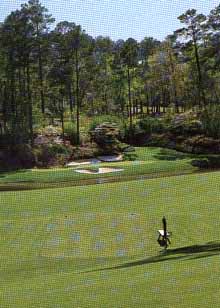 |
A deep breath and I sent the ball scuttling along the fairway, which swoops down at least 50 feet in a left-hand dogleg towards a bunker resembling a massive white golf glove.
My next found the ‘palm’ of the sand, my third a steep slope in front of the green and my fourth a leaf-strewn lie on the back fringe. Three putts later I suddenly had great sympathy for Scott Hoch who had three-stabbed two years earlier in a playoff with Nick Faldo. Choke? I was gasping for air! A triple-bogey seven.
The grips on the clubs I had borrowed from my colleague Alistair Tait on the rival publication ‘Golf Monthly’, were getting more slippery by the minute despite the best efforts of the trusty ‘Blue’. So it was no surprise when I dumped my approach into the water short of the 11th. Another seven.
Par at the 12th
The green at the par-3 12th (Golden Bell) is sheltered by giant pines and from 155 yards looks smaller than a Ping-Pong table. Rae’s Creek beckons at the front of the green but having selected a 6-iron my effort sailed to the back fringe from where I tentatively putted down the slope for my par.
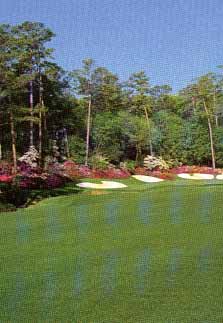 |
A three on the 12th! Jack Nicklaus had taken seven the day before. Golden Bell? Golden Bear? Golden balls, more like!
The 13th tee is tucked behind a permanent TV tower and my honour was short-lived as I topped my drive short of the creek, which separates it from the sharp dogleg-left fairway. My next bobbled into the water…penalty stroke, now playing four.
Having reached the corner of the dogleg, Blue plucked out a fairway wood and told me to ‘go for it, Sir. You’ll never get another chance!’
A career 5-wood to the front edge of the putting surface but three more stabs on a tiered, slippery green completed an ugly nine. However, it was comforting to know Tommy Nakajima, he of the disaster at St Andrew’s 17th, had taken 13 here in 1978.
A seven and a six followed at 14 and 15 (where I laid up like a chicken at the par-5 on Blue’s advice) and dunked my tee shot into the dyed navy blue water at the intimidating par-3 16th.
A double-bogey five followed with my second ball but I’m still amazed how the members at Augusta can rate this the easiest hole on the course, according to the stroke index. Fail to get the ball on the correct spot on the green and as Ray Floyd once discovered, the wicked slopes can have you shaping up to your putt with your back to the hole!
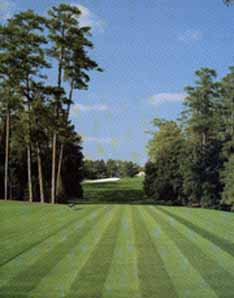 |
The tee shot at 18 – I had a regulation bogey at the uphill 17th - is one of the most daunting in golf. How Woosie managed to fly those bunkers with a persimmon-headed driver the day before, is still a mystery.
From an elevated tee, the fairway swoops down 60 feet then up to the right to a green that is normally surrounded by 20,000 colourful patrons and millions more watching on TV.
On this day it was deserted, apart from workmen dismantling the recorder’s box, but the cheers for the Welshman’s major-winning 10-foot par putt were still ringing through the trees. My three-footer for a five was my 54th stroke of the day, so far.
The Front nine
The group ahead, which included the noted TV presenter Jim Nance, had reached the first green by the time we mounted the tee to start the front nine. In 2002 the tee has been moved back 25 yards to bring the bunker on the right into play for the pros but even with a head start 11 years ago it still caught me.
Thanks to Augusta’s policy change over TV coverage, many of you will be able to appreciate the subtleties of the front nine for the first time this year, including the first green which is probably the toughest on the course to two-putt.
With its subtle borrows, even Tiger’s relieved to get away with a par. For me a bogey five felt like a birdie!
The second, a downhill par-5 over 500 yards, demands a blind tee shot through an avenue of trees. The green, 100 feet wide and less than 30-feet from front to back is reckoned by the pros to be a give-away birdie chance.
For mere mortals like me, however, I was happy to avoid the cavernous bunkers each side of a narrow opening and get out of there with a six.
Another shallow green perched 20 feet above the fairway is the main defence of the 360-yard third, while putting on the exposed par-3 fourth green was like rolling a ball on a boardroom table. My second putt from four-feet left me grateful to hole to 10-footer for double bogey coming back!
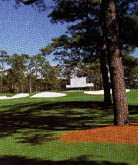 |
The par-4 fifth at 435 yards, is stroke index one for members and I was happy to get away with a five while an identical number secured a double bogey at the downhill par-3 sixth on a green that has more of a back ledge than a back tier.
Known as Pampas, because of the small plantation of golden grass that stands sentry to the left of the fairway, the seventh has been extended by nearly 50 yards this year.
Back in ’91 pros were punching a long iron into position down a narrow fairway then flipping wedges to an elevated green protected by three deep bunkers at the front and two at the back.
My six was hard enough then. Next week, for Tiger and Co it could be a card-wrecker.
All bets are on!
It was at this point that I revealed to my caddie that I had accepted a bet with a colleague that I would not break 100 round Augusta National. And this got his attention. Such a remark tends to infer that there may well be something in it for the bag man if the wager bears fruit.
With the par-5 8th and dogleg 9th to come – and 91 blows having already been struck - there was an outside chance but ‘we’ really needed a birdie.
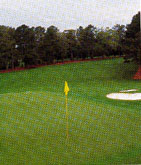 |
'Blue' got down on his knees to read ‘our’ 30-foot birdie attempt on the undulating 8th green, such was its importance and to my untrained eye it needed to start four feet left of the hole. However, he convinced me it should start two feet right and when it lipped out after a roller-coaster ride, was mortified it hadn’t dropped.
A par at the 9th – my third of the day, for a round 100 (54 out, 46 back) – signalled a hearty slap on the back from my new-found friend, hoping that I hadn’t thought too badly of his efforts on my behalf, even though I’d loss my bet by a whisker.
And when I peeled off three $10 notes to add to his agreed fee he seemed genuinely appreciative. Gripping my hand he said: ‘You de man, Sir! You played nice, today." And I felt he meant it.
It was a privilege and an honour to hit my ball around Augusta National Golf Club – an opportunity few handicap golfers can say they have had.
And 11 years on, it still brings a tingle of excitement to recall those words ‘Y’all both in!’ which provided the chance to turn a dream into reality.
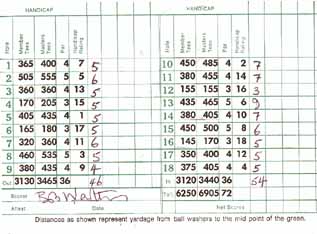 |
If your interested in golf abroad then take a look at our
href="http://www.golfmagic.com/travel/travel.asp?sp=&v=3#Europe"
target=_BLANK>Travel Partners who specialise in golfing breaks to European and Worldwide destinations.

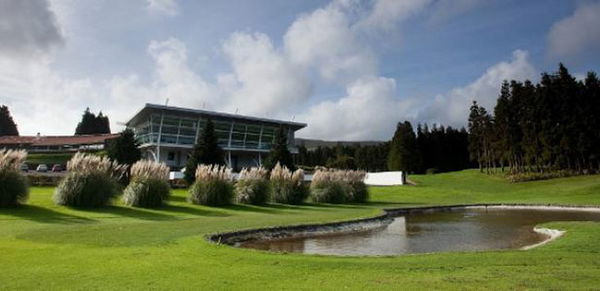
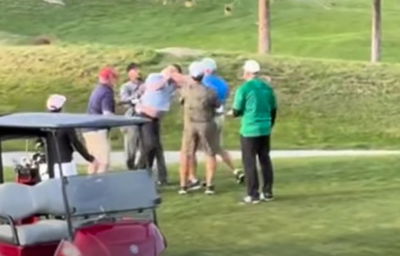
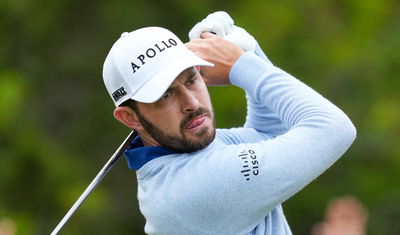
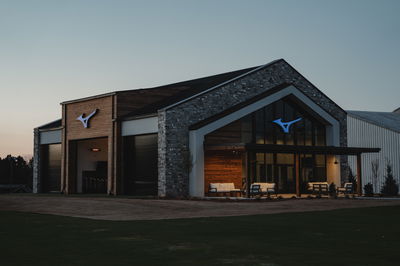
![Wesley Bryan [The Duels: Miami]](https://cdn.golfmagic.com/2025-04/bryan22222.jpg?width=400)
